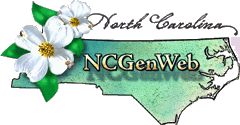Bethpage: Its Roots Are Deeply Imbedded In Cabarrus County
by Randolph S. Hancock, Independent Staff Writer
The Daily Independent, Kannapolis, NC, September 18, 1955
submitted by Bill Furr
Wild pea vine was growing lush on Piedmont savannas. Easterly winds, week before, had told the great humped herd on the western plains the time had come for the annual trek to the eastern seaboard. The buffalo followed the winding path of their ancestors across the plains, through the Great Smokies and down the foothills of the Blue Ridge. They were cautious creatures. Centuries of traveling this route had taught them that danger often lurked behind the most unsuspecting hedge of bushes.
There was first the Indian. Later there had come the white man. He had brought with him an instrument of sudden death. On the creek bank this spring stood a man with a long rifle. When the buffalo stopped to drink from the sparkling and refreshing waters, the rifle belched red. There was one less animal to follow the thundering herd in its mad dash toward the coast.
Bethpage has come a long way since the 1790’s. The community’s roots are many. They have spread through Cabarrus County, the state and nation deeper and further than there’s any authentic record. Elder T. A. Flemming of the Bethpage Presbyterian Church admits as much in an historical sketch written in 1937.
Said Mr. Flemming, “In the absence of records it is the province of history to gather and preserve authentic tradition and incident and thus; place conspicuously before the present and coming generations of Presbyterians the mellow light of ancestral example.” White the light of ancestral example has mellowed, it hasn’t dimmed in Bethpage. It’s an outstanding community.
Mr. Flemming concerned himself in his “sketch” with the work of the Presbyterian Church in Bethpage. That’s important. It’s outstanding. But it is only one phase or just a dot on the canvas that is Bethpage.
For two years running, Bethpage has been honored and recognized as Cabarrus County’s most “Outstanding Community” by the County Council of Home Demonstration Clubs. That’s an honor few, if any, communities in North Carolina can boast. That wasn’t enough for Bethpage. It went on last year to take the honor of having the “Club Woman of the Year” named from the community. She is Mrs. Evelyn Brown, a second grade teacher in the Aycock school in Kannapolis. Mrs. Brown is also the retiring president of the community Home Club.
Such honors have roots in solid footings. Bethpage had such a footing in the “mellow light of an ancestral example. . .” The first settlements within the bounds of Bethpage (it’s difficult to say just where the bounds begin and end) “where made by Scotch-Irish emigrants from Pennsylvania and Delaware several anterior (sic) to the revolution,” says Mr. Flemming in his sketch. There undoubtedly are many persons in Bethpage today who are descendants of those first settlers. But others have come. There are many German names prominent in the community.
Mr. Flemming say’s “they (the first settlers) were rugged of character; almost all were soldiers in the revolutionary armies.” Less the wonder then that they were “jealous of their civil and religious liberties, stern and unyielding where principle was involved, intensely loyal to Presbyterianism with them the church was a power.”
Bethpage Presbyterian Church had its beginning in humble quarters. “The first church,” said Mr. M N. Petrea, the oldest living elder of the church, “was a log church on Buffalo Creek.” It was known as “Old Bethpage” and it was built about 1794. “That there was a place of preaching,” says Mr. Flemming, “. . . before there was a church organization is not matter of doubt.
Mr. Flemming adds that “tradition says that there was a preaching place on the East bank of Buffalo Creek, about two-and-a-half miles from the sight of Old Bethpage . . . there was a graveyard there now entirely obliterated. . .”
Mr. Flemming was not without levity. “The writer,” said he, “has heard an anecdote of that period. A tardy worshiper having arrived after service had concluded to enter by climbing over the wall and did so just as the preacher was reading his text from John: 1. “He that entereth not by the door into the sheep fold but climbeth some other way, the same is a thief and a robber!” Just exactly what that “climber over the wall” elected to do after hearing his “sins” read aloud, Mr. Flemming failed to say. Suffice it to say, he was chagrined. Perhaps he jumped into nearby Buffalo Creek!
Bethpage probably took its name from a community in Judea. In Hebrew the word loosely translated means “house or tent” and since the church was the forerunner of the community, it was aptly named Bethpage.
Following the log church on the creek, there was built “a more imposing edifice” where the Bethpage Methodist Church now stands. This site was sold to the Methodist and the present building was erected about 1840. However, these dates appear in the stone at the entrance to the church: 1794, 1840, 1933.
Building is to be continued. The Rev. John A. Cannon Jr., pastor said present plans call for a $70,000 sanctuary to be built adjacent to the present building, west side. To carry on this work, Mr. Cannon said the congregation of the church had raised $12,000 since Jan. 16. Construction of the modern new building is scheduled to begin next summer.
Energetic, personable Mr. Cannon, a man with a feeling for youth, has organized a softball team among the youth of the church, a Boy Scout troop (No. 105) and under his supervision there’s a year-round recreation program for young people in the basement of the church. While the ball team ended in seventh place in the circuit this year, Mr. Cannon is expecting bigger and better things come next season. It was a start and a good one. Bethpage softball enthusiasts can look forward to a top team next year.
The church now has 294 members. In the Sunday School there are 200 enrolled. Last year Sunday School enrollment had dropped to 140.
As in the beginning most activity revolves around the church. Mr. Cannon pointed out that T. P. Sims, an elder, is one of the most “aggressive members of the congregation. He takes care of the cemetery” where rest many of the community’s first settlers.
In sight of the church is the Community Center. That’s a place of general meeting for community functions. It’s a unifying force in Bethpage too.
Dairy farming is the principal occupation of the people of Bethpage. There are two “Honor Farms” or “Green Farms” in Bethpage. They are operated by Hugh Rumple and Ralph Williams. This honor came to Mr. Rumple and Mr. Williams for the outstanding pastures they provide for their dairy cattle. It’s an honor not easily come by.
Bethpage has also felt the “building boom” that has struck the country. Within the past 12 months a number of $12,000 to $15,000 modern homes have been built in the community. That’s Bethpage now. It came up from ten acres of land.
May 19, 1795 Hugh McCrea started Bethpage on its way when he caused to be executed a deed for 10-acres of land on the shores of Buffalo Creek. The deed was executed in the names of George Gibson, John Parks, Archibald Woodsides and Mitchell Flemming. Since that time more land has been sold or deeded to the church. Persons selling or deeding land to the church have included Miss Sophia Overcash, 50 acres, for S100. Charles Rumple deeded a lesser number of acres to the church. Bethpage’s first pastor was the Rev. John Carrigan. The records show that Concord presbytery held its first meeting in the church Dec. 24, 1795.
The wild peavine still grows in open spots in Piedmont. The war-whoop of the Indians – which Mr. Flemming touched on in his sketch – is no longer to be heard. But Buffalo Buffalo creek flows on – minus its namesake … minus the man with the rifle – and so does the community it nurtured.


